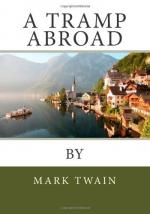Dr. Forbes, the English geologist, had made frequent visits to the Mont Blanc region, and had given much attention to the disputed question of the movement of glaciers. During one of these visits he completed his estimates of the rate of movement of the glacier which had swallowed up the three guides, and uttered the prediction that the glacier would deliver up its dead at the foot of the mountain thirty-five years from the time of the accident, or possibly forty.
A dull, slow journey—a movement imperceptible to any eye —but it was proceeding, nevertheless, and without cessation. It was a journey which a rolling stone would make in a few seconds—the lofty point of departure was visible from the village below in the valley.
The prediction cut curiously close to the truth; forty-one years after the catastrophe, the remains were cast forth at the foot of the glacier.
I find an interesting account of the matter in the HISTOIRE du Mont Blanc, by Stephen d’Arve. I will condense this account, as follows:
On the 12th of August, 1861, at the hour of the close of mass, a guide arrived out of breath at the mairie of Chamonix, and bearing on his shoulders a very lugubrious burden. It was a sack filled with human remains which he had gathered from the orifice of a crevice in the Glacier des Bossons. He conjectured that these were remains of the victims of the catastrophe of 1820, and a minute inquest, immediately instituted by the local authorities, soon demonstrated the correctness of his supposition. The contents of the sack were spread upon a long table, and officially inventoried, as follows:
Portions of three human skulls. Several tufts of black and blonde hair. A human jaw, furnished with fine white teeth. A forearm and hand, all the fingers of the latter intact. The flesh was white and fresh, and both the arm and hand preserved a degree of flexibility in the articulations.
The ring-finger had suffered a slight abrasion, and the stain of the blood was still visible and unchanged after forty-one years. A left foot, the flesh white and fresh.
Along with these fragments were portions of waistcoats, hats, hobnailed shoes, and other clothing; a wing of a pigeon, with black feathers; a fragment of an alpenstock; a tin lantern; and lastly, a boiled leg of mutton, the only flesh among all the remains that exhaled an unpleasant odor. The guide said that the mutton had no odor when he took it from the glacier; an hour’s exposure to the sun had already begun the work of decomposition upon it.
Persons were called for, to identify these poor pathetic relics, and a touching scene ensured. Two men were still living who had witnessed the grim catastrophe of nearly half a century before—Marie Couttet (saved by his baton) and Julien Davouassoux (saved by the barometer). These aged men entered and approached the table. Davouassoux, more than eighty years old, contemplated the mournful remains mutely and with a vacant eye, for his intelligence and his memory were torpid with age; but Couttet’s faculties were still perfect at seventy-two, and he exhibited strong emotion. He said:




